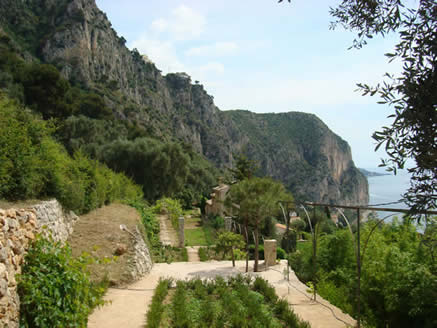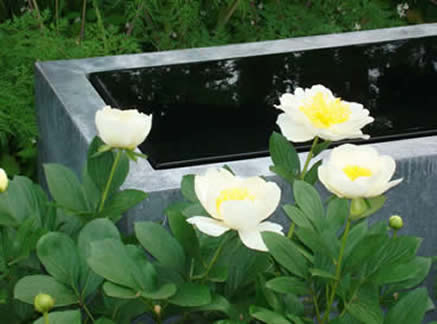|
Of crags and roses
June 23, 2008
The scary part of any design project is when it starts to take concrete (or timber, or stone, or metal) form. In the mind’s eye it is fluid, on paper easily modified, but when the plans are drawn up and work begins on the ground it is a brave designer who has no last minute doubts.
I have been planning a garden for three years now in one of Europe’s most spectacular locations, high above the Mediterranean, on terraces between immense craggy cliffs and the sea. Cap Ferrat and the waters of Beaulieu Bay lie below, and above a steep wild hillside where old grey olive trees and deep green Aleppo pines lead the eye up to ochre limestone crags. The terraces still bear survivors of the old culture of olives and vines and lemons. It is a long garden, the narrow top terrace 125 metres, rising in three long steps to the monumental olive tree that brings it to its mysterious shady close. From under its branches, looking back along the terraces, the eye embraces the whole panorama of cliffs, garden and sea, where Cap d’Ail is a long finger on the horizon.
This spring the garden took its definitive shape. The centre part of the top terrace is a tunnel of vines trained on a simple arched metal pergola. From the house, two terraces below, it appears as a cloister of shady voids and green columns backed by a high stone wall. At its lower end the cloister leads to a boule court shaded by ancient olive and bay trees. Going the other way it opens to a simple formal space where a central box-edged path leads between orange and lemon trees, filtering the view of the sea, and a broad bed of Hydrangea
Sharp focus
June 10, 2008
A week away in early June and you come back to a different garden. It was wet while we were gone, and warm enough for plants to make their main thrust of growth, to bulk up and cover ground. Last night, just home, I walked round in a daze of excitement, surprise, shock and, I confess, dither. So much needs enjoying, so much needs doing. Instinctive priorities are new plants, just planted. Have they survived my disloyal absence?
A fresh eye for your own garden is never easy to achieve. Homecoming gives you your best chance. Has the fatsia grown too bulky (yes), or the hedge too tall? Does the Robinia ‘Frisia’ shout too loud beside the purple cotinus? This is the moment to decide. But how do you prevent yourself from stopping to pull up an egregious weed…. Then another and another? Contemplation and quiet consideration go by the board once you start stooping – which is why they are fragile commodities around here.
My friends groan when I tell them I love weeding. After propagating, though, it accounts for my happiest gardening hours, most absorbed and closest to my plants. There is gross weeding, when I straighten up all sweaty with armfuls of goose grass and nettles and dock, and fine weeding which scarcely fills a trug but leaves a bed looking like a jewel box.
Both make me focus and concentrate. Weeds rampaging intertwined disguise themselves as their betters. Tiny seed leaves, mere hints of a plant, challenge me to identify them. And decide whether they are going to add to or subtract from the picture in question.
Herb Robert its everywhere at the moment. Who can possibly dislike this lusty little geranium, so agile in
Augustine blues
May 14, 2008
We were in Snowdonia for the spring: all six days of it. We went in what felt like the end of winter; branches all but bare, fat flower buds on the ashes but not the oaks (last year it was the other way round). We came home in early summer; the biggest difference of all being the beeches, which had managed to unfurl, shake out and spread at least their first four leaves per twig. They were still in that state of infinite tenderness when the shoot is a slender, silky green-grey extension weighed down by almost transparent wisps of leaves, but the sky was full of them, green in the majority over blue as you looked up. Bluebells, open only on sheltered primrose banks before, were jostling in deep violet crowds. Birches and larches were a haze of bright yellow apple green.
I admit I felt cheated. I need leisure to revel in spring. A long day at the office and I would have missed the best part of it. Happily I was in the woods, trying vainly to capture the metamorphosis on my camera. I lay under a rhododendron under a beech, knowing that the picture could fail dismally to convey the filtering light, the pale purple, paler green and intense sky blue woven in restless shades, knowing that the only way really to see is to put away your camera, stop even thinking, and live in your eyeballs.
The rhododendron is R. augustinii, the nearest (admittedly not very near) to blue. Among the shades of violet and lilac, in dappled sun and shade, they can seem as blue as bluebells. When we acquired our wood, 13 years ago, I planted a dozen R. augustinii along streams and by little waterfalls. I pretty much left them to take their chance. A wood is not a garden; the dustpan and brush have no place in forestry. Despite neglect nine of the twelve have flourished. Last autumn I cleared the invading birch, gorse, bracken and
|

Work in progress
quercifolia and agapanthus. Agapanthus is the default summer flower here – at least in the early stages, before we are tempted to diversify. I hope we manage to keep all the planting simple. The pergola
continues as a single row of metal arches, rose and vine covered, concealing and revealing the great open view directly down to the bay and across to Cap Ferrat.
At each break of level, three times where the long terrace climbs across the mountain slope, a plain iron pipe splashes water into a concrete reservoir, a repeated thread of water that leads the eye and ear upwards. Rough tufa catches the splash, absorbs it and provides a home for moss and ferns. Beside each tank stone stairs, with a barrow-ramp up the middle, lead up to the next level. At the bottom, two terraces down, the water reappears as the source for a grey-blue swimming pool, pergola’d off from the house with climbing roses and a bed already brimming with blue and purple, Salvia uliginosa, Verbena bonariensis, and white Japanese anemones.
The doubts? Can we maintain the sense of ancient agriculture, of working terraces and reservoirs, while embowering them in flowers? Can we do anything but trivialize what is already an epic panorama by horticulturizing it?

scrambling? It fragile pink stems, forking and forking again, its leaves, dividing and subdividing into more andmore palmate parts, its tiny pink flowers and its odd smoky smell have a potent charm, whether procumbent, when it is a great improvement on bare soil, or clambering up on the shoulders of a stronger plant. Its giant exotic cousin, Geranium maderense, almost identical in construction and behaviour, is after all a showpiece we have been proud to welcome to our ever-warmer gardens.
Tom Stuart-Smith, speaking about his triumphant Chelsea garden last month, said how important it was to finish planting several days ahead of the show, so that plants could settle down and adopt their natural positions – a thought that hadn’t occurred to me before. Of course flowers and leaves turn to take best advantage of the light, maneuvering in relation to one another like people in a crowd. It is easy to see where something has been added, or if you are weeding, subtracted. Even easier to see where the gardener’s boot has been. It is one of the joys of this time of year that beds brim with leaves in pristine condition and perfect alignment, flowers stalks getting ready to go, as blithe and beamish as schoolchildren.
Intricacy can’t be taken in quickly; a fact that Tom S-S’s garden eloquently expressed. There were brilliantly decisive touches: a single white peony, for example, against one of his grey rectangles of perfectly polished water. But between there were passages of soft planting to slow down the eye. It is a fact of garden making that big and simple is quick and easy – not necessarily satisfying for longer and quieter contemplation. The natural embroidery of many kinds of leaves rewards focussed concentration – especially, for that matter, when some of them are weeds.
brambles around them. This spring their slender framework and little flowers, as elaborate as orchids, graced the shifting light under beeches and larches like puffs of smoke. I shall plant more. To plant anything else would be gardening.
Of course we went to Bodnant. I had never been there at the cusp of the rhododendron season before, and was ébloui (there are English words, I know, but don’t you love the French?) by the colours, the scale, the mastery of this extraordinary garden cum forest. It made me concentrate on the question of colour. It goes wrong when a bright or strong colour is isolated. A single red flower among pinks is effectively a weed. Red and white are the colours to be most careful with: they need careful grouping with plenty of green. One path in the upper garden is dedicated entirely to red rhodos, with truly regal effect. Down the cascade by the old mill, on the other hand, red fights pink and white, not so much a patchwork as an outbreak of measles.
Even blue, soft as it is, is best played alone.
Fellow gardeners
The R.H.S. is evolving at a dizzying rate these days. It has to, of course, to keep up with a world that spins faster every year. I sometimes wonder, though, if in its headlong expansion it risks losing sight of the quiet pleasures that attract so many gardeners. Carlo Petrini, the founder of the Slow Food movement, reacted to the arrival of the first Golden Arches in Rome, with a boom worthy of his friend Pavarotti. ‘Food,’ he thundered, ‘should be slow’ – and pronounced it ZLOOOOOW. Gardening, too. Slow means tranquil, private, considered, personal, uncompetitive, contemplative…….. all the unfashionable adjectives you can think of. Show gardens are one thing; showing off is what they do. Private gardens exist to nourish the soul of an individual.
Does the R.H.S. recognize that among its members there are many (how many?) whose love of plants and nurturing them is a lifelong affair, going far beyond fashion? Its earlier members (earlier than the 1980s) used to be called Fellows, until that came to seem an inflated appellation for every recruit.
Wouldn’t it be an apt recognition, though, for those who remain loyal to the Society for, let’s say, 20 years? Seniority, you may say, proves nothing. Some of us will be ignorant and idle however long we live. Perhaps Fellowship should be earned in some more demanding way. It will always be a very long way from the Victoria Medal of Honour, which is held by only 63 outstandingly distinguished gardeners at any one time. There is such a thing as Honorary Fellowship, awarded to a select few. It seems a pity, though, for the concept of Fellowship of what remains, at least in part, a learned Society should go by default.
|